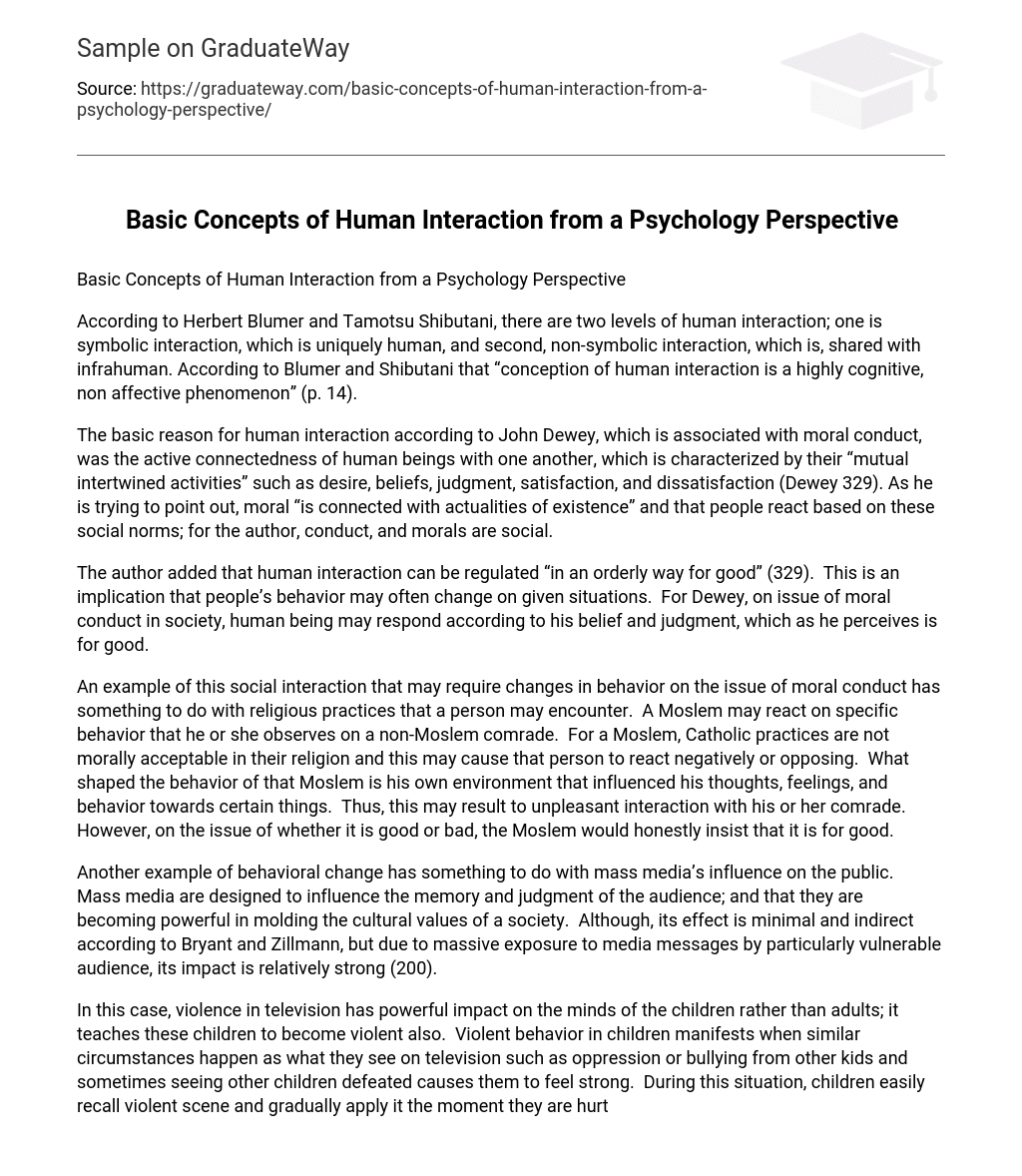According to Herbert Blumer and Tamotsu Shibutani, there are two levels of human interaction; one is symbolic interaction, which is uniquely human, and second, non-symbolic interaction, which is, shared with infrahuman. According to Blumer and Shibutani that “conception of human interaction is a highly cognitive, non affective phenomenon” (p. 14).
The basic reason for human interaction according to John Dewey, which is associated with moral conduct, was the active connectedness of human beings with one another, which is characterized by their “mutual intertwined activities” such as desire, beliefs, judgment, satisfaction, and dissatisfaction (Dewey 329). As he is trying to point out, moral “is connected with actualities of existence” and that people react based on these social norms; for the author, conduct, and morals are social.
The author added that human interaction can be regulated “in an orderly way for good” (329). This is an implication that people’s behavior may often change on given situations. For Dewey, on issue of moral conduct in society, human being may respond according to his belief and judgment, which as he perceives is for good.
An example of this social interaction that may require changes in behavior on the issue of moral conduct has something to do with religious practices that a person may encounter. A Moslem may react on specific behavior that he or she observes on a non-Moslem comrade. For a Moslem, Catholic practices are not morally acceptable in their religion and this may cause that person to react negatively or opposing. What shaped the behavior of that Moslem is his own environment that influenced his thoughts, feelings, and behavior towards certain things. Thus, this may result to unpleasant interaction with his or her comrade. However, on the issue of whether it is good or bad, the Moslem would honestly insist that it is for good.
Another example of behavioral change has something to do with mass media’s influence on the public. Mass media are designed to influence the memory and judgment of the audience; and that they are becoming powerful in molding the cultural values of a society. Although, its effect is minimal and indirect according to Bryant and Zillmann, but due to massive exposure to media messages by particularly vulnerable audience, its impact is relatively strong (200).
In this case, violence in television has powerful impact on the minds of the children rather than adults; it teaches these children to become violent also. Violent behavior in children manifests when similar circumstances happen as what they see on television such as oppression or bullying from other kids and sometimes seeing other children defeated causes them to feel strong. During this situation, children easily recall violent scene and gradually apply it the moment they are hurt or every time they see opportunity to inflict harm. Such behavior is learned which the child agrees to be correct and lawful as what dictates by the world of mass media. Behavioral aggressiveness then is due to existing idea that it is proper to defend oneself and be like a hero on his own way. Without parental guidance, this becomes the standard norm or value that a child learns throughout his life. Consequently, the child develops a different identity and mindset toward his or her environment.
Human interaction then is influenced by individual’s thought, feeling, and beliefs towards his environment; and this may dictate him to react negatively or positively, or to agree to disagree based on his judgment as proper. Success in human interaction lies on the commonness of idea, beliefs, and judgment of people towards something.
Work Cited
Blumer, H. & Shibutani, T. 1973. Human Nature and Collective Behavior: Papers in Honor of Herbert Blumer. USA: Transaction Publishers
Bryant, J. & Zillmann, D. 2002. Media Effects: Advances in Theory and Research. Lawrence Erlbaum Associates
Dewey, J. 2005. Human Nature and Conduct: An Introduction to Social Psychology. Kessinger Publishing





